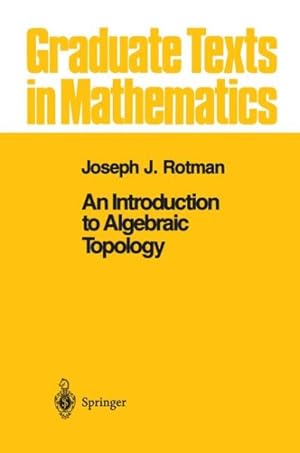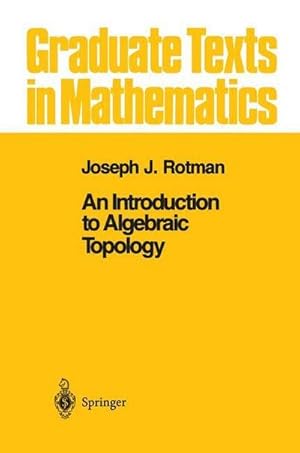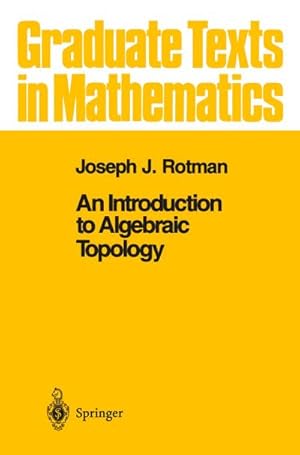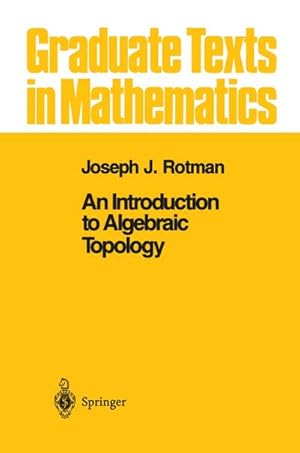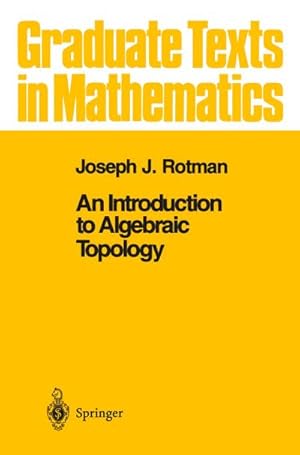Introduction Algebraic Topology by Rotman Joseph (36 results)
Search filters
Product Type
- All Product Types
- Books (36)
- Magazines & Periodicals (No further results match this refinement)
- Comics (No further results match this refinement)
- Sheet Music (No further results match this refinement)
- Art, Prints & Posters (No further results match this refinement)
- Photographs (No further results match this refinement)
- Maps (No further results match this refinement)
- Manuscripts & Paper Collectibles (No further results match this refinement)
Condition Learn more
- New (29)
- As New, Fine or Near Fine (3)
- Very Good or Good (4)
- Fair or Poor (No further results match this refinement)
- As Described (No further results match this refinement)
Binding
Collectible Attributes
- First Edition (1)
- Signed (No further results match this refinement)
- Dust Jacket (No further results match this refinement)
- Seller-Supplied Images (16)
- Not Print on Demand (27)
Language (1)
Free Shipping
Seller Location
Seller Rating
-
An Introduction to Algebraic Topology (Graduate Texts in Mathematics, 119)
Seller: World of Books (was SecondSale), Montgomery, IL, U.S.A.
Condition: Very Good. Item in very good condition! Textbooks may not include supplemental items i.e. CDs, access codes etc.
-
An Introduction to Algebraic Topology (Graduate Texts in Mathematics, 119)
Seller: Textbooks_Source, Columbia, MO, U.S.A.
First Edition
hardcover. Condition: New. First Edition. Ships in a BOX from Central Missouri! UPS shipping for most packages, (Priority Mail for AK/HI/APO/PO Boxes).
-
An Introduction to Algebraic Topology (Graduate Texts in Mathematics, 119)
Seller: Friends of Pima County Public Library, Tucson, AZ, U.S.A.
Condition: New. Hardcover. NOT Ex-library. Like new. Clean pages and tight binding. Until further notice, USPS Priority Mail only reliable option for Hawaii. Proceeds benefit the Pima County Public Library system, which serves Tucson and southern Arizona.
-
An Introduction to Algebraic Topology
Published by Springer, New York & Berlin, 1988
ISBN 10: 0387966781 ISBN 13: 9780387966786
Language: English
Hardcover. Condition: Very Good. Graduate Texts In Mathematics, 119; Large 8vo 9" - 10" tall; 451 pages; 1988 Springer Verlag. HC snugly bound in original yellow and white paper covered boards. Contents bright and fresh with no marks. Mild nicks to paper covering boards at corner tips and head of spine. Solid unmarked copy. VG.
-
An Introduction to Algebraic Topology (Graduate Texts in Mathematics)
Seller: Books From California, Simi Valley, CA, U.S.A.
paperback. Condition: Very Good.
-
Condition: As New. Unread book in perfect condition.
-
Condition: New.
-
An Introduction to Algebraic Topology (Graduate Texts in Mathematics, 119)
Seller: Lucky's Textbooks, Dallas, TX, U.S.A.
Condition: New.
-
An Introduction to Algebraic Topology (Graduate Texts in Mathematics)
Seller: Ria Christie Collections, Uxbridge, United Kingdom
US$ 82.69
US$ 15.73 shipping from United Kingdom to U.S.A.Quantity: Over 20 available
Add to basketCondition: New. In.
-
An Introduction to Algebraic Topology (Graduate Texts in Mathematics, 119)
Seller: Ria Christie Collections, Uxbridge, United Kingdom
US$ 82.69
US$ 15.73 shipping from United Kingdom to U.S.A.Quantity: Over 20 available
Add to basketCondition: New. In English.
-
PF. Condition: New.
-
US$ 82.67
US$ 19.70 shipping from United Kingdom to U.S.A.Quantity: Over 20 available
Add to basketCondition: New.
-
Condition: New. pp. 460.
-
An Introduction to Algebraic Topology (Graduate Texts in Mathematics, 119)
Seller: California Books, Miami, FL, U.S.A.
Condition: New.
-
Condition: New. pp. 460 52:B&W 6.14 x 9.21in or 234 x 156mm (Royal 8vo) Case Laminate on White w/Gloss Lam.
-
An Introduction to Algebraic Topology
Published by Springer-Verlag New York Inc., US, 1988
ISBN 10: 0387966781 ISBN 13: 9780387966786
Language: English
Seller: Rarewaves.com USA, London, LONDO, United Kingdom
Hardback. Condition: New. 1st ed. 1988. Corr. 4th printing 1998.
-
US$ 93.44
US$ 19.70 shipping from United Kingdom to U.S.A.Quantity: Over 20 available
Add to basketCondition: As New. Unread book in perfect condition.
-
Condition: New. pp. 458.
-
An Introduction to Algebraic Topology
Published by Springer New York, Springer New York Aug 1988, 1988
ISBN 10: 0387966781 ISBN 13: 9780387966786
Language: English
Seller: buchversandmimpf2000, Emtmannsberg, BAYE, Germany
Buch. Condition: Neu. Neuware -There is a canard that every textbook of algebraic topology either ends with the definition of the Klein bottle or is a personal communication to J. H. C. Whitehead. Of course, this is false, as a glance at the books of Hilton and Wylie, Maunder, Munkres, and Schubert reveals. Still, the canard does reflect some truth. Too often one finds too much generality and too little attention to details. There are two types of obstacle for the student learning algebraic topology. The first is the formidable array of new techniques (e. g. , most students know very little homological algebra); the second obstacle is that the basic defini tions have been so abstracted that their geometric or analytic origins have been obscured. I have tried to overcome these barriers. In the first instance, new definitions are introduced only when needed (e. g. , homology with coeffi cients and cohomology are deferred until after the Eilenberg-Steenrod axioms have been verified for the three homology theories we treat-singular, sim plicial, and cellular). Moreover, many exercises are given to help the reader assimilate material. In the second instance, important definitions are often accompanied by an informal discussion describing their origins (e. g. , winding numbers are discussed before computing 1tl (Sl), Green's theorem occurs before defining homology, and differential forms appear before introducing cohomology). We assume that the reader has had a first course in point-set topology, but we do discuss quotient spaces, path connectedness, and function spaces.Springer Verlag GmbH, Tiergartenstr. 17, 69121 Heidelberg 456 pp. Englisch.
-
An Introduction to Algebraic Topology
Published by Springer New York, Springer New York Okt 2011, 2011
ISBN 10: 1461289300 ISBN 13: 9781461289302
Language: English
Seller: buchversandmimpf2000, Emtmannsberg, BAYE, Germany
Taschenbuch. Condition: Neu. Neuware -There is a canard that every textbook of algebraic topology either ends with the definition of the Klein bottle or is a personal communication to J. H. C. Whitehead. Of course, this is false, as a glance at the books of Hilton and Wylie, Maunder, Munkres, and Schubert reveals. Still, the canard does reflect some truth. Too often one finds too much generality and too little attention to details. There are two types of obstacle for the student learning algebraic topology. The first is the formidable array of new techniques (e. g. , most students know very little homological algebra); the second obstacle is that the basic defini tions have been so abstracted that their geometric or analytic origins have been obscured. I have tried to overcome these barriers. In the first instance, new definitions are introduced only when needed (e. g. , homology with coeffi cients and cohomology are deferred until after the Eilenberg-Steenrod axioms have been verified for the three homology theories we treat-singular, sim plicial, and cellular). Moreover, many exercises are given to help the reader assimilate material. In the second instance, important definitions are often accompanied by an informal discussion describing their origins (e. g. , winding numbers are discussed before computing 1tl (Sl), Green's theorem occurs before defining homology, and differential forms appear before introducing cohomology). We assume that the reader has had a first course in point-set topology, but we do discuss quotient spaces, path connectedness, and function spaces.Springer Verlag GmbH, Tiergartenstr. 17, 69121 Heidelberg 456 pp. Englisch.
-
Taschenbuch. Condition: Neu. An Introduction to Algebraic Topology | Joseph J. Rotman | Taschenbuch | xiv | Englisch | 2011 | Humana | EAN 9781461289302 | Verantwortliche Person für die EU: Springer Verlag GmbH, Tiergartenstr. 17, 69121 Heidelberg, juergen[dot]hartmann[at]springer[dot]com | Anbieter: preigu.
-
An Introduction to Algebraic Topology (Graduate Texts in Mathematics)
Seller: Revaluation Books, Exeter, United Kingdom
Paperback. Condition: Brand New. reprint edition. 473 pages. 8.75x6.00x1.25 inches. In Stock.
-
An Introduction to Algebraic Topology
Published by Springer New York, Springer US, 2011
ISBN 10: 1461289300 ISBN 13: 9781461289302
Language: English
Seller: AHA-BUCH GmbH, Einbeck, Germany
Taschenbuch. Condition: Neu. Druck auf Anfrage Neuware - Printed after ordering - There is a canard that every textbook of algebraic topology either ends with the definition of the Klein bottle or is a personal communication to J. H. C. Whitehead. Of course, this is false, as a glance at the books of Hilton and Wylie, Maunder, Munkres, and Schubert reveals. Still, the canard does reflect some truth. Too often one finds too much generality and too little attention to details. There are two types of obstacle for the student learning algebraic topology. The first is the formidable array of new techniques (e. g. , most students know very little homological algebra); the second obstacle is that the basic defini tions have been so abstracted that their geometric or analytic origins have been obscured. I have tried to overcome these barriers. In the first instance, new definitions are introduced only when needed (e. g. , homology with coeffi cients and cohomology are deferred until after the Eilenberg-Steenrod axioms have been verified for the three homology theories we treat-singular, sim plicial, and cellular). Moreover, many exercises are given to help the reader assimilate material. In the second instance, important definitions are often accompanied by an informal discussion describing their origins (e. g. , winding numbers are discussed before computing 1tl (Sl), Green's theorem occurs before defining homology, and differential forms appear before introducing cohomology). We assume that the reader has had a first course in point-set topology, but we do discuss quotient spaces, path connectedness, and function spaces.
-
An Introduction to Algebraic Topology
Published by Springer New York, Springer New York, 1988
ISBN 10: 0387966781 ISBN 13: 9780387966786
Language: English
Seller: AHA-BUCH GmbH, Einbeck, Germany
Buch. Condition: Neu. Druck auf Anfrage Neuware - Printed after ordering - There is a canard that every textbook of algebraic topology either ends with the definition of the Klein bottle or is a personal communication to J. H. C. Whitehead. Of course, this is false, as a glance at the books of Hilton and Wylie, Maunder, Munkres, and Schubert reveals. Still, the canard does reflect some truth. Too often one finds too much generality and too little attention to details. There are two types of obstacle for the student learning algebraic topology. The first is the formidable array of new techniques (e. g. , most students know very little homological algebra); the second obstacle is that the basic defini tions have been so abstracted that their geometric or analytic origins have been obscured. I have tried to overcome these barriers. In the first instance, new definitions are introduced only when needed (e. g. , homology with coeffi cients and cohomology are deferred until after the Eilenberg-Steenrod axioms have been verified for the three homology theories we treat-singular, sim plicial, and cellular). Moreover, many exercises are given to help the reader assimilate material. In the second instance, important definitions are often accompanied by an informal discussion describing their origins (e. g. , winding numbers are discussed before computing 1tl (Sl), Green's theorem occurs before defining homology, and differential forms appear before introducing cohomology). We assume that the reader has had a first course in point-set topology, but we do discuss quotient spaces, path connectedness, and function spaces.
-
An Introduction to Algebraic Topology (Graduate Texts in Mathematics)
Seller: Mispah books, Redhill, SURRE, United Kingdom
Hardcover. Condition: Like New. Like New. book.
-
An Introduction to Algebraic Topology
Published by Springer-Verlag New York Inc., US, 1988
ISBN 10: 0387966781 ISBN 13: 9780387966786
Language: English
Seller: Rarewaves.com UK, London, United Kingdom
US$ 102.52
US$ 85.37 shipping from United Kingdom to U.S.A.Quantity: Over 20 available
Add to basketHardback. Condition: New. 1st ed. 1988. Corr. 4th printing 1998.
-
Condition: Gut. Zustand: Gut | Sprache: Deutsch | Produktart: Bücher.
-
An Introduction to Algebraic Topology
Published by Springer New York Okt 2011, 2011
ISBN 10: 1461289300 ISBN 13: 9781461289302
Language: English
Seller: BuchWeltWeit Ludwig Meier e.K., Bergisch Gladbach, Germany
Taschenbuch. Condition: Neu. This item is printed on demand - it takes 3-4 days longer - Neuware -A clear exposition, with exercises, of the basic ideas of algebraic topology. Suitable for a two-semester course at the beginning graduate level, it assumes a knowledge of point set topology and basic algebra. Although categories and functors are introduced early in the text, excessive generality is avoided, and the author explains the geometric or analytic origins of abstract concepts as they are introduced. 456 pp. Englisch.
-
An Introduction to Algebraic Topology
Published by Springer New York Aug 1988, 1988
ISBN 10: 0387966781 ISBN 13: 9780387966786
Language: English
Seller: BuchWeltWeit Ludwig Meier e.K., Bergisch Gladbach, Germany
Buch. Condition: Neu. This item is printed on demand - it takes 3-4 days longer - Neuware -A clear exposition, with exercises, of the basic ideas of algebraic topology. Suitable for a two-semester course at the beginning graduate level, it assumes a knowledge of point set topology and basic algebra. Although categories and functors are introduced early in the text, excessive generality is avoided, and the author explains the geometric or analytic origins of abstract concepts as they are introduced. 456 pp. Englisch.
-
An Introduction to Algebraic Topology
Seller: Biblios, Frankfurt am main, HESSE, Germany
Condition: New. PRINT ON DEMAND pp. 460.





